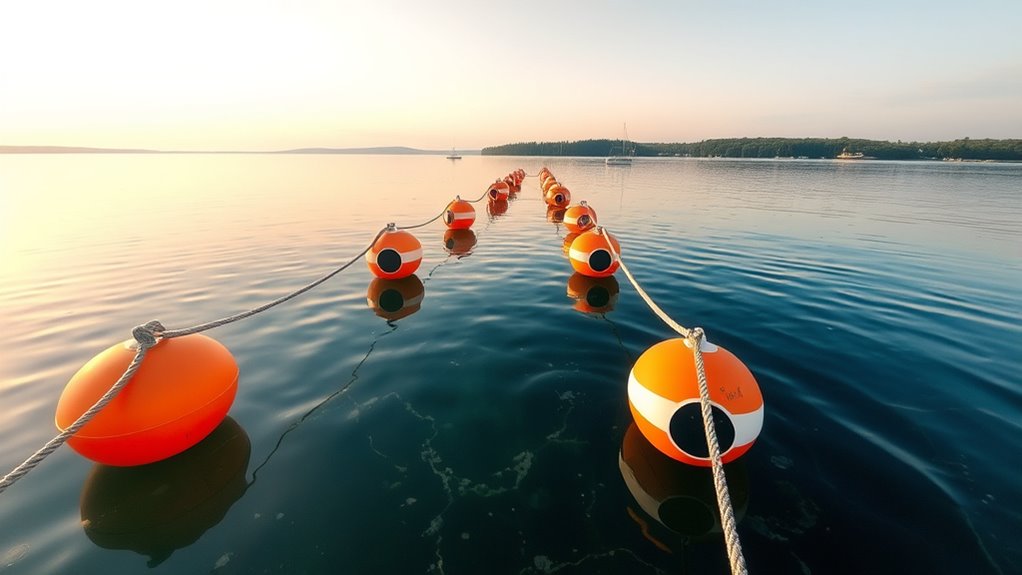Using floating markers and buoys correctly is key to maintaining safe navigation and protecting marine ecosystems. You should carefully consider their placement, ensuring they follow water currents, depth, and obstacles to prevent accidents and reduce clutter. Regular maintenance and visibility features like bright colors and lights help you stay aware of hazards while minimizing environmental impact. When you pay attention to proper positioning and eco-friendly choices, you’ll keep waterways safe and sustainable— there’s more to discover on how to do this effectively.
Key Takeaways
- Proper placement of buoys ensures clear navigation routes and reduces the risk of collisions or accidents.
- Use high-visibility colors and reflective materials to enhance marker visibility in all lighting conditions.
- Regularly inspect and maintain markers to ensure they are functional, correctly positioned, and environmentally safe.
- Consider environmental factors like currents, depth, and underwater obstacles when deploying markers.
- Choose eco-friendly materials and responsible placement practices to protect marine ecosystems while ensuring safety.

Have you ever wondered how boats navigate safely through waters filled with hidden hazards? It’s a critical question, especially when you consider the importance of floating markers and buoys. These small but essential devices serve as guiding beacons, helping boats stay on course and avoid dangerous areas. Proper placement of floating markers isn’t just about convenience; it’s a matter of navigation safety that can prevent accidents and save lives. When you understand how these markers work, you realize they’re more than simple floats—they’re vital tools that streamline maritime traffic and enhance safety standards.
Floating markers and buoys are essential tools ensuring safe navigation and preventing accidents at sea.
However, while ensuring navigation safety is paramount, it’s equally important to think about the environmental impact of deploying these markers. Incorrect placement or careless maintenance can cause harm to marine ecosystems. For example, some markers are made of materials that might leach harmful chemicals into the water if not chosen carefully. Additionally, poorly placed buoys can become hazards themselves, snagging equipment or disturbing the natural habitat of marine life. As you work with floating markers, it’s crucial to select eco-friendly materials and follow guidelines that minimize environmental disruption. This approach helps preserve the health of aquatic ecosystems while maintaining effective navigation routes.
Placement also plays a key role in balancing safety and environmental considerations. Markers need to be positioned precisely—too close together, and they might clutter the water or cause confusion; too far apart, and they risk leaving gaps that could lead to accidents. You should consider factors like water currents, depth changes, and underwater obstacles when placing buoys. Proper placement of these markers is essential for optimal safety and environmental protection. Consistent maintenance and regular checks are necessary to ensure they remain visible and functional, especially during rough weather or heavy traffic. By doing so, you’re ensuring that navigation safety is upheld without harming the environment.
Furthermore, the design of floating markers can influence their impact. Bright colors and reflective surfaces improve visibility, making navigation safer, especially in low-light conditions. Some markers are equipped with solar-powered lights, reducing energy consumption and further lowering environmental impact. When you choose the right type of buoy or marker, you’re not only improving safety but also demonstrating responsible environmental stewardship. Combining thoughtful placement, proper maintenance, and eco-conscious choices helps create a sustainable approach to maritime navigation that benefits everyone involved—boaters, marine life, and the environment alike.
In essence, using floating markers and buoys effectively means being mindful of both navigation safety and environmental impact. It’s about striking a balance that keeps waterways safe for all users while protecting the ecosystems that rely on clean, healthy waters. When you approach this task with care and responsibility, you contribute to safer, more sustainable maritime practices that can be appreciated by generations to come.
Frequently Asked Questions
How Are Buoy Materials Chosen for Different Water Conditions?
You choose buoy materials based on durability and water compatibility. For harsh conditions, you select tough, corrosion-resistant materials like high-density plastics or treated metals that withstand weather, sunlight, and saltwater. In freshwater or calmer waters, lighter materials may suffice. By considering these factors, you guarantee your buoys stay functional and visible, reducing safety risks and maintenance needs over time.
What Maintenance Is Required for Floating Markers?
You need to regularly inspect your floating markers and follow cleaning protocols to keep them visible and functional. Clean off algae, dirt, and debris to prevent deterioration. Keep an eye on their condition and replace them according to the replacement schedules, especially if they show signs of wear or damage. Proper maintenance guarantees safety, longevity, and clear navigation, preventing accidents and maintaining effective waterway markers.
How Do Buoy Systems Adapt to Changing Weather?
You need to regularly inspect and adjust buoy systems to guarantee weather adaptability and marker visibility. During storms or high winds, secure or reposition buoys to prevent drifting, and use reflective or brightly colored markers for better visibility in poor weather. Keeping communication with maintenance teams helps you respond swiftly to changing conditions, ensuring safety and clear navigation even when weather varies. This proactive approach maintains effective marker placement regardless of weather challenges.
Can Floating Markers Be Used in Icy Waters?
Yes, floating markers can be used in icy waters, but you need to prioritize ice safety and winter deployment. Choose markers made of durable, weather-resistant materials that withstand freezing temperatures. Verify they’re securely anchored to prevent drifting under ice. Regularly check and adjust their positions to account for ice movement or melting. Proper planning and maintenance help keep these markers effective and safe during winter conditions, guiding navigation safely.
What Legal Regulations Govern Buoy Placement?
Think of buoy placement like following a map in uncharted waters—you must adhere to maritime law and environmental regulations. These laws specify who can place buoys, their exact locations, and safety standards to prevent accidents and protect ecosystems. For example, local authorities often require permits for marking navigational hazards. Ignoring these rules risks fines or dangerous incidents, so always check with relevant agencies before setting up floating markers.
Conclusion
By carefully placing floating markers and buoys, you help create a safe haven on the water, guiding others gently through potentially tricky areas. When you pay attention to their placement, you’re subtly ensuring everyone’s journey stays smooth and secure. Think of these markers as quiet guardians, working behind the scenes to keep adventures enjoyable for all. With thoughtful placement, you’re contributing to a harmonious and worry-free environment—making every trip a pleasant memory for everyone involved.










